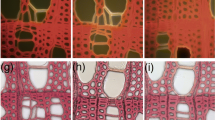Abstract
TRASHY leaf is brown, worthless leaf occurring in flue-cured tobacco; its prevalence causes a substantial loss to the Australian tobacco industry1. In the investigation of this phenomenon, it is essential that means be available of detecting trashiness at an early stage in uncured leaf. Cured leaf can usually be separated on physical properties into several grades varying from normal to fully trashy. This does not apply to uncured leaf, where gradation in trashiness remains masked. A method is described here whereby the presence of trashiness in dried uncured leaf can be readily detected. This method is based on the differential fluorescence of normal and trashy leaves under ultra-violet light.
Similar content being viewed by others
References
Johanson, R., Aust. J. Sci. Res., B, 4, 231 (1951).
Best, R. J., Aust. J. Exp. Biol., 26, 223 (1948). Andreae, W. A., Nature, 170, 83 (1952).
Author information
Authors and Affiliations
Rights and permissions
About this article
Cite this article
JOHANSON, R. Differential Fluorescence in Identification of Tobacco Trashy Leaf. Nature 171, 753–754 (1953). https://doi.org/10.1038/171753a0
Published:
Issue Date:
DOI: https://doi.org/10.1038/171753a0
- Springer Nature Limited
This article is cited by
-
Papierchromatographische Differenzierung einiger Arten und Sorten der GattungPopulus
Der Züchter (1962)
-
Development of amenenic leaf in tobacco
Die Naturwissenschaften (1954)





